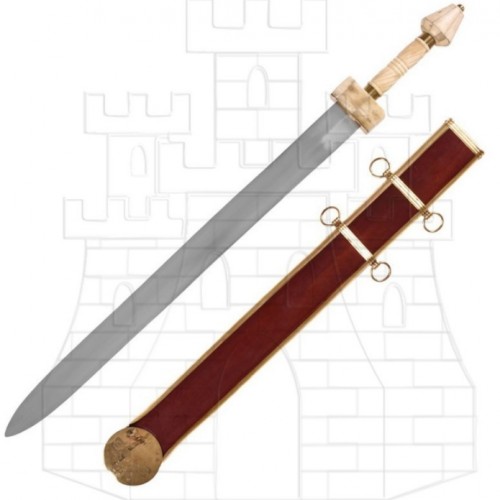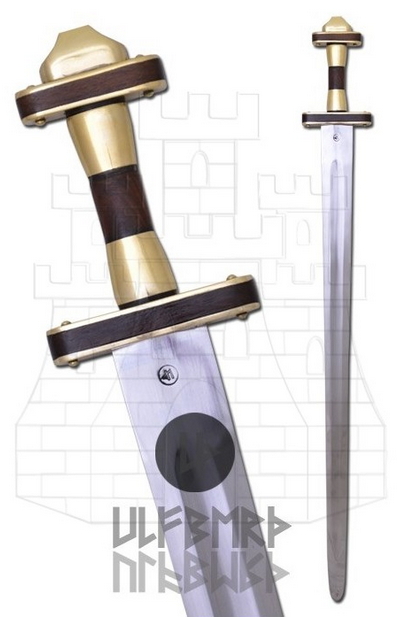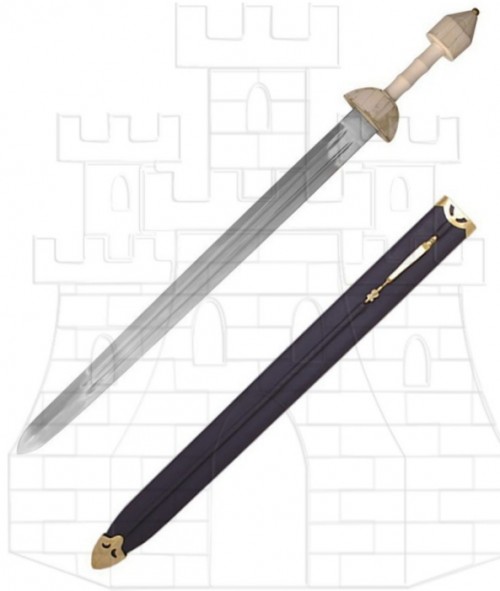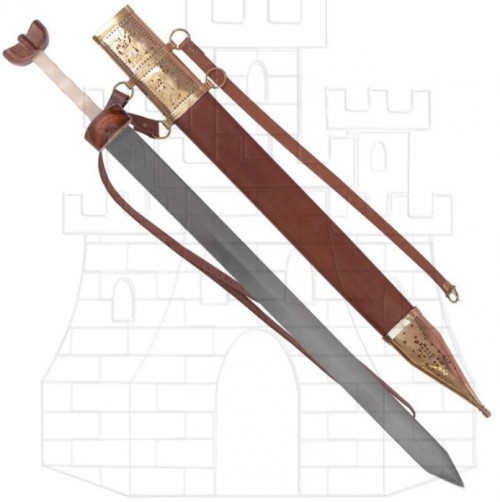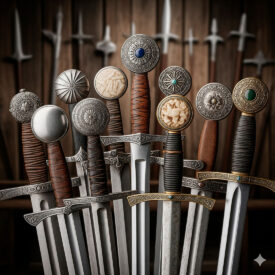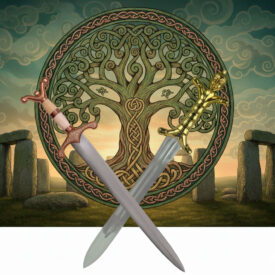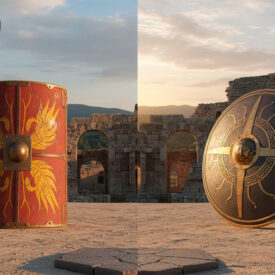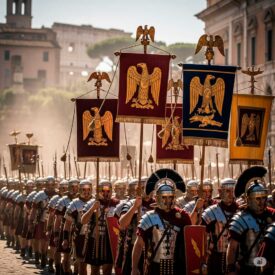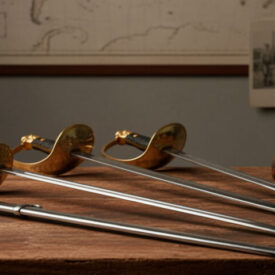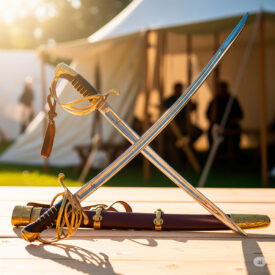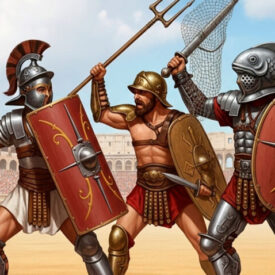Types of Spathas: From Roman Cavalry to the Medieval Sword
Legend has it that in the Empire’s border camps, the clang of long steel heralded the arrival of a new era. The spatha was not just another sword; it was the bridge between the compact efficiency of the gladius and the grandeur of medieval swords. What types exist, how are they identified, and why do they matter to historians and reenactors? In this text, you will discover its evolution, the typologies of blade and hilt, the keys to dating, and which current replicas best reproduce these classic models.
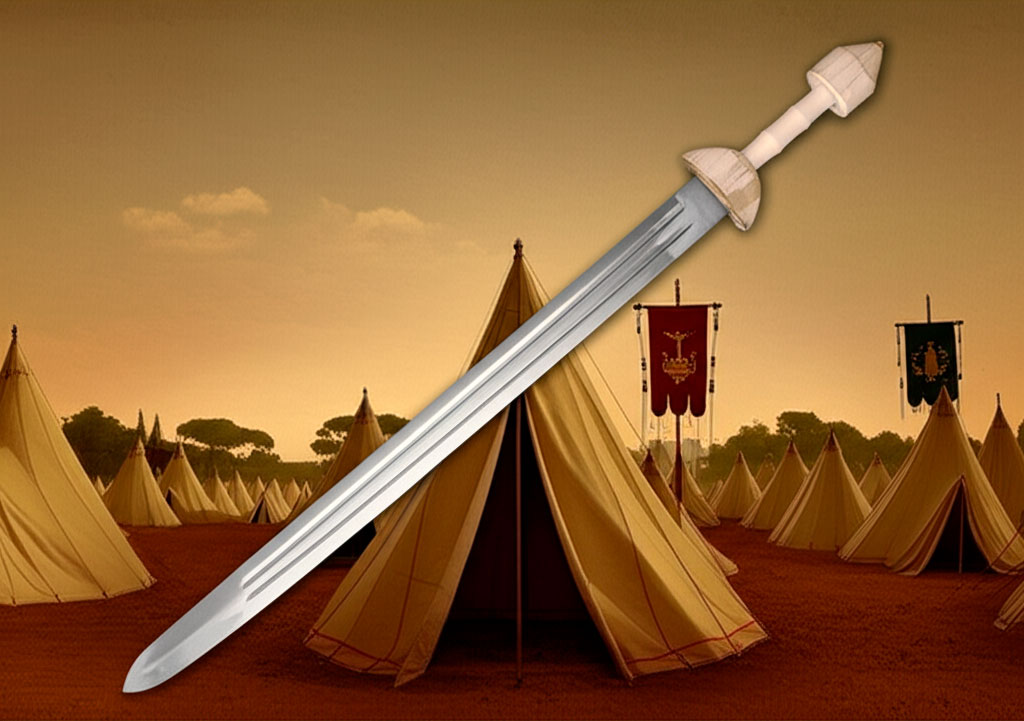
Evolution and Origin: The Spatha in Historical Context
Originating from Central European traditions, the spatha was incorporated into the Roman army as an essential cavalry weapon from the late Republic and early Empire. With a longer blade than the gladius, between 70 and 100 cm in the most extensive examples, it allowed for powerful cutting and maintaining distance in mounted combat.
During the 3rd and 4th centuries AD, the spatha spread to the Roman infantry and, shortly thereafter, to barbarian peoples, becoming the archetype of the late antiquity sword. This transition had tactical implications: the infantry partially abandoned close-quarters combat by closing ranks and adopted a weapon that prioritized cutting and flexibility of use, especially in battles where cavalry played a decisive role.
Chronology of the Spatha: Essential Dates and Milestones
Placing key moments on a timeline helps to understand how formal features respond to political, military, and cultural changes. Below is a chronology that synthesizes the most relevant milestones from its adoption by Rome to its survival in medieval Europe.
- 1st Century BC: Introduction of the spatha into Central European Celtic cavalry units.
- 1st Century AD: Classical texts (Arrian) identify the spatha as a cavalry weapon.
- Mid-2nd Century AD: Expansion of its use among Roman troops beyond cavalry.
- Late 3rd – early 4th Centuries: Discoidal chape models and persistent Roman forms; homogenization under the fabricae armorum.
- 4th Century: Typological diversification (Lauriacum, Straubing, Osterburken, etc.) and widespread adoption by the barbaricum.
- 5th Century: Sumptuous types and variants with cloisonné; Childeric’s sword (ca. 481) exemplifies decorative lavishness.
- 6th Century and beyond: Persistence of regional types; transition to medieval hand-and-a-half and longswords.
- 800–1100: Continued use of models in Northern Europe, including Vikings.
Why Chronology Matters for Identifying a Spatha
Dating doesn’t just depend on blade length; small details—a fuller, the shape of the pommel, the decoration of the mouthpiece, or the suspension system—are the chronological signature that allows a piece to be placed within a temporal and geographical framework.
Blade Typologies: Keys to Recognizing Variants
Modern studies (Biborski & Ilkjær; Christian Miks) offer two classification systems that complement each other when analyzing archaeological finds. Here we summarize the most representative types and their distinctive features.
Classification according to Biborski and Ilkjær (main types)
- N-K (Nydam-Kragelund): Relatively light, symmetrical sections, and up to two fullers; persistent until the third quarter of the 4th century.
- S (Snipstad): Wide, with many fullers (up to six); appears at the beginning of the 4th century and disappears towards its last quarter.
- V-H (Voien-Hedelisker): Narrow, converging edges, without fullers; develops between the beginning of the 4th and mid-5th century.
- E-S (Esbjol-Sarry): Very narrow, symmetrical, without fullers; first half of the 4th to the last quarter of the 5th century.
- O-V (Osterburken-Vrasselt): Wide with a rounded tip and a wide fuller; from mid-4th to 6th century.
Classification according to Christian Miks (broad European sample)
- Lauriacum-Hromówka: Very wide, almost parallel edges, rounded tip; documented from the 2nd century to the beginning of the 4th.
- Straubing-Nydam (and variants Einang, Ejsbøl): Converging edges, lengths 65–80 cm; variants with parallel fullers.
- Illerup-Whyl: Similar to Straubing but with bandförmig or biconcave sections and a wide central fuller.
- Osterbunken-Kemathen: Extremely wide, short and triangular tip, clearly a cutting weapon.
- Asian/Pontic type (Pannonhalma): Very long blades with large and decorated crossguards; possible steppe origin.
Comparative Table: Blade Types (Biborski/Miks)
| Type | Features | Typical Length | Chronology |
|---|---|---|---|
| Lauriacum-Hromówka | Wide blade, parallel edges, rounded tip | 70–90 cm | 2nd Century – early 4th |
| Straubing-Nydam | Converging edges; variants with fullers | 65–80 cm | 1st–4th |
| Illerup-Whyl | Bandförmig/biconcave sections; wide central fuller | 70–85 cm | 3rd–5th |
| Osterburken-Kemathen | Very wide; short tip; cutting weapon | 70–80 cm | 4th–6th |
| Pannonhalma (Asian) | Extremely long blade; broad and decorated crossguards | 90–100+ cm | 4th–5th |
Hilts and Adornments: Chronological Reading in Hand
The hilt offers one of the most solid clues for dating a spatha. The materials, rivet buttons, and the presence of decorative plates speak of workshops, trade networks, and cultural preferences.
- Behmer I (Nydam): Cylindrical wood with four thinnings; from early 4th to mid-5th century.
- Behmer II (Vøien-Gruppe): Grip covered with decorated metal sheet; Northern Europe, mid-4th — late 5th century.
- Behmer III: Sumptuous pieces with gold and cloisonné; mid-5th — first quarter of the 6th century.
- Behmer IV (oriental): Carved stone pommel; late 4th — late 5th century.
- Behmer V (Hourglass): Spindle-shaped grip with metal sheet; mid-3rd — late 6th century.
- Behmer VI: Pyramidal pommel button; from mid-5th century.
Metal Appliqués and Rivet Caps
Rivet buttons (Holmegard-Kragehul, Vieuxville, Knarremose, Nummedal) and decorative caps (Naviform, Snartemo-Blučina, Pyramidenförmiger) have precise chronological horizons. Identifying them allows for a more secure narrowing of a piece’s dating than isolated observation of the blade.
Scabbards and Suspension Systems: The Complement that Betrays Origin
The organic scabbard rarely survives complete, but its metal appliqués (mouthpieces, bridges, chapes) do. These elements are studied to define provenances and timelines.
- Mouthpieces: Types with openwork, with ribs, with bird heads, with niello or cloisonné offer regional and temporal signals.
- Suspension bridges: A single bridge is characteristic of the 4th century; the pair of bridges became prevalent from the 5th century.
- Chapes: Discoidal, U-shaped, Gundremmingen type, or Kastenortband are variants that allow dating between the 3rd and 6th centuries.
Comparative Table: Mouthpieces and Bridges
| Element | Features | Period |
|---|---|---|
| Openwork Mouthpiece | Perforated bronze plate | Early 3rd – first quarter 5th |
| Ribbed Mouthpiece | Perforated and ribbed, very popular | Second half of the 4th |
| Solitary Bridge (Laschenkopf) | Simple strap fastening | Early 4th |
| Pair of Bridges (Nydam-Porskaer) | Double system that improves suspension | 5th Century |
| Gundremmingen type Chape | Three projecting studs | Last quarter 3rd – early 5th |
How to Study a Spatha: Step-by-Step Method
Scientific study combines archaeology, typology, and metallurgy. If you have access to a piece or images, follow this summarized protocol:
- Observe the blade: length, width, presence and number of fullers.
- Examine the hilt: material, shape, presence of rivets or metal plates.
- Analyze the scabbard: type of mouthpiece, bridges, chape.
- Typological comparison with catalogs (Biborski, Miks, Behmer) and stratigraphic evidence if available.
- If possible, perform metallographic tests to determine composition and heat treatment.
Replicas, Museography, and Functional Models
Modern replicas allow for experimenting with proportions and handling, but their historical value depends on fidelity in materials and construction. Some functional replicas reproduce cloisonné hilts, fullers, and wide crossguards; others prioritize durability for cutting tests.
Replicas and Available Models
Modern Comparison: Spatha vs. Derived Swords
To understand its legacy, it’s useful to compare lengths, uses, and design objectives.
| Type | Blade Length | Main Use | Spatha Heritage |
|---|---|---|---|
| Classic Spatha | 70–100 cm | Cavalry, late infantry | Base of the medieval hand-and-a-half sword |
| Hand-and-a-half Sword (bastard) | 90–100 cm | 1–2 hand versatility | Adaptation to mixed tactics |
| Two-handed Sword | 120–180 cm | Reach and force in open field | Exaggeration of the spatha’s reach principle |
| Rapier/Estoc | ~100 cm | Civil fencing and duel, thrust | Divergence: prioritizes thrust and precision |
How to Recognize an Authentic Spatha in Images or Museums?
- Look for longitudinal fullers (1–3) and the blade section: bandförmig or biconcave indicates certain types.
- The pommel and crossguards decorated with cloisonné or rivets allow for chronological placement.
- The presence of a pair of suspension bridges suggests post-400 AD dating.
- Chapes with studs or U-shaped indicate local traditions and specific periods.
Interpreting a spatha requires patience: many examples are the result of technological and aesthetic mixtures, fruit of imperial workshops, local craftsmanship, and war booty.
Legacy: From Spatha to the European Sword
The spatha left a lasting mark. Its length and ergonomics encouraged longer handles, more flexible blades, and guards that protected the hand. Over time, these transformations led to hand-and-a-half swords and long cavalry and infantry swords.
Beyond technique, the spatha is a narrative: it testifies to Roman adaptation to new threats and their assimilation of barbaric tools; in turn, from the spatha arises the symbolic form of the sword that we will see during the Middle Ages and the Early Modern Age.
VIEW ROMAN SPATHAS | VIEW ROMAN GLADIUSES | VIEW MEDIEVAL SWORDS
